|
|
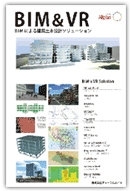 |
Discussion of image from model creation to how to make an presentation
Virtual Design World Cup, Workshop Vol.2 and 3
All workshops of Virtual Design World Cup were completed on July 22, 2011.
The students were influenced by the ideas of other members and the advice
from the instructor, Mr. Hiroo Kasagi (NPO Chiiki zukuri kobo), and they
started on the model creation.
In this issue, the workshop vol.2 (June 27) and vol.3 (July 22) are reported.
In addition, we will introduce the sample model of shibuya and the pedestrian
deck. |
|
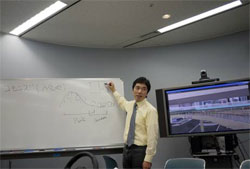 |
Mr. Hiroo Kasagi, NPO Chiiki zukuri kobo
Instructor of three workshops |
 |
| Workshop Vol.2: Discussion of image and creation of proposal |
Concept of city development
In this workshop vol.2, there were 6 participants. In his greeting, Mr.
Kasagi sent a message to the students on the purpose of this workshop by
encouraging them to give an inspiration of creation to other participants
through web cloud service, to develop their idea, and to share their information
using web service.
Then, the teams were organized and team members introduced themselves.
Six students from two universities were randomly put into two teams. They
shared the image of Shibuya while reviewing the previous workshop.
"This time, you will make a proposal of the assumed pedestrian deck.
Through this process, you will discuss the meaning of city design and how
to make a presentation."(Mr. Kasagi)
Before starting the discussion and research for the image of pedestrian
deck, Mr. Kasagi briefly gave a tutorial on "Concept of development"
and the meaning of workshop.
"The city development consists of three parts; 1st stage, 2nd stage,
and 3rd stage. If we progress through these three stages, the feedback
from each step will result in a good design. The process of feedback is
really important for the city development."(Mr. Kasagi) In addition,
he advised to use UC-win/Road and VR-Cloud (TM) to conduct a discussion
of what image of shibuya they would create? Questions like, "How to
create based on the image?" "What is the purpose and what kind
of deck one should create based on the field study?" were discussed.
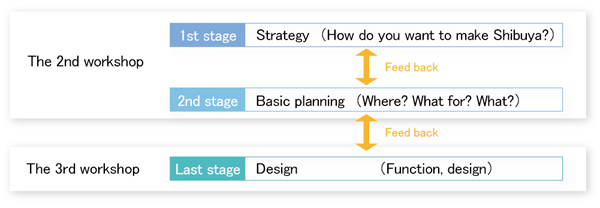 |
| Figure1 "Concept of city development" and the meaning of workshop
by Mr. Kasagi |
Consideration of image by Team A
The students started to discuss on where they settle the pedestrian deck
while checking the list of model parts. "In Shibuya, as the scramble
crossing (West side) is dangerous, we need to solve this issue." "As
the backside (East exit) looks bare and the pedestrian deck is a little
old, we need to create something to be a new symbol" It seemed that
there were many opinions on the settled place.Mr. Kasagi advised the students
based on their opinions saying "What type of image do you want to
portray of Shibuya? For example, whether people are passing just passing
by or gathering, if you identify the purpose as to what kind of function
you want the pedestrian deck to have, you come up with a place to settle
the deck."
Finally, Team A selected the bus terminal on the east exit where Hikarie
is situated by arranging the parts. They made a discussion by arranging
the parts on the deck and checking the image with consideration of the
advice from Mr.Kasagi "It is important to fix the concept".Team
A, proceeding the discussion with the paper on which they itemized the
concepts. They prepared for the presentation based on it.
| A: "Universal" Team |
Concept "Universal design of new landmark where people gather"
- Creation of new symbol of Shibuya city
- Improvement of the accessibility to Omotesando and Aoyama direction
- Universal design
|
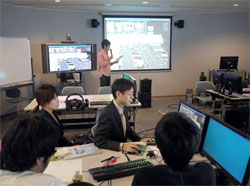 |
|
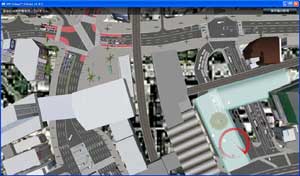 |
| 1:Presentation based on three concepts |
|
2:Overview image, the improvement of the accessibility to Omotesando and
Aoyama direction |
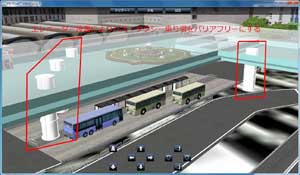 |
|
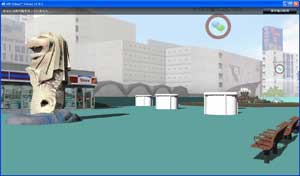 |
3: The taxi stands and bus station can be free of barriers by setting up
an elevator. Besides, covered roof will keep people out of the rain.
|
|
4:The deck will be more effective to construct as the commercial facility
which has the convenience store and other shops with a large area across
the station terminal. In addition, the deck can be used to ease congestion
on the scramble crossing as the new meeting spot as an alternative to Hachi-ko
by settling the fountain. |
|
Consideration of image by Team B
The student who joined the previous workshop commented that "The front
side of scramble crossing and the backside on the east exit contrast with
each other remarkably in terms of people's flow and landscape." They
made an discussion which side they should arrange the deck on.
"The backside where Hikarie was under construction is not too barren
but it is in need of decoration. I am wondering how the bus terminal here
will become in the future."On the other hand, the students commented
on the scramble crossing that contrasted with the backside saying "It
situation can remain as it is". Finally, the opinions were summarized
to the east exit.
In this way, both Team A and B selected the same place. After this decision,
they started to study what kind of deck they want to create while checking
the parts list.
"Shibuya has the image of the newest. I want to make it a new symbol
as the replacement for the scramble crossing." "How about making
the passage made of glass by connecting with Hikarie."
After the concrete image was fixed, they planned the shape of "8"
by connecting the two circular parts. With consideration of the opinion
in the previous field work, "It causes the interruption of flow and
lighting due to the covering on the bus terminal.", they selected
the parts which has holes in the center of its circular shape.
| B: "Shibuya 8" Team |
Concept "New symbol SHIBUYA"8"(Hachiko)"
| Creation of future with "Outgoing of the culture in near future"
by symbolized by Hikarie and the concept of "SHIBUYA 8" which
will be an alternative symbol to Hachiko as the waiting spot. |
|
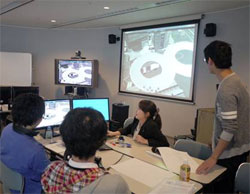 |
|
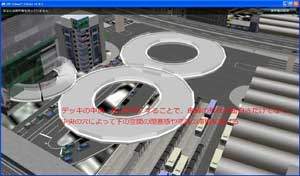 |
| 1:Presentation with the motif of "8" from Hachiko |
|
2: Figure 8 can be an alternative symbol of Hachi-ko (Hachi in Japanese
means eight) on the scramble crossing side. |
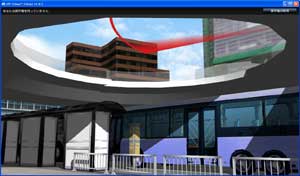 |
|
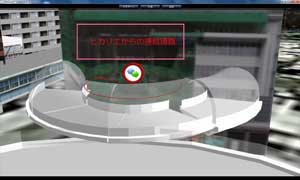 |
| 3: The holes of figure 8 will provide the solution for a sense of limitation
and the convection flow of air under the deck. |
|
4: As the theater is built in Hikarie, it can be used for the waiting spot
after /before the performance |
|
During the 10 minutes of break, they referred to the planning by another
team and realized they all chose the same settlement place (Figure2). After
that, they were stimulated by the plan of another team, and each team made
a discussion even though it was still break time. Therefore, the discussion
time was extended.
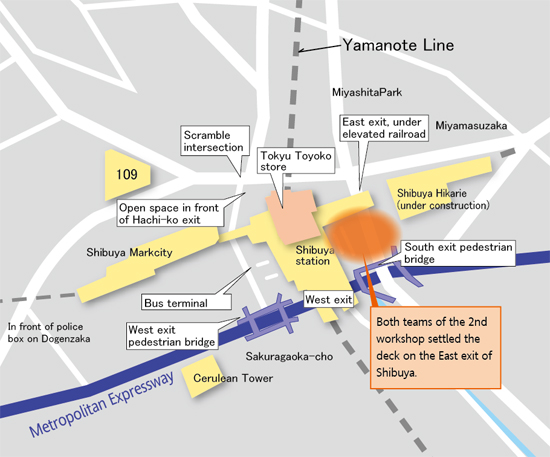 |
| Figure2 Both teams selected the same place, above the bus terminal on the
east exit. |
Presentation with VR-Cloud(TM)
After finishing one and a half-hour of the discussion and study, the idea
of planning was updated on VR cloud, and they made a presentation on the
image and concept of pedestrian deck while operating VR-Cloud(TM). There
were a lot of questions and answers on the idea of planning.
Team A made a presentation on how they dealt with the three concepts, (1)
Creation of nes symbol of Shibuya city (2) Improvement of the accessibility
(3) Universal design. Mr. Kasagi evaluated as the easy-to-understand presentation.B
team planned a figure-eight deck which allows the direct connection to
Hikarie above the bus terminal on East exit, and named their team as "Shibuya
Eight".
After both presentations, Mr. Kasagi mentioned "If the same place
is selected, the results will be different. I think the other participants
are inspired by this idea. It is very important for the city development
to discuss with many different opinions and ideas."
In addition, Mr. Kasagi explained the meaning of the theme of this competition,
"Deck" in the city development, with the concept of "Commons".
It helps the students understand the theme of this competition.Finally,
we wrapped up the workshop by saying "We will publicize the reports
on the website, write up the contents of our discussion on VR space, and
release the data based on today's work on the website in order to share
our information with those who weren't in the workshop in hope of increasing
the level of the workshop" with a sense of prospect and connection
to the 3rd workshop.
| Workshop Vol.3: Examining how to show |
Share the concept of the work in the group
The workshop vol.3 was the final one. As the purpose and content of workshop
in this time, the last group division and the data created by each were
took over and used as the base, and "how each person is conscious
for how to show the work.. (=Visualization work is conducted.)". Team
A consisted of 4 students, and Team B consisted of three students (3 joined
the previous workshop).
Mr. Kasagi explained that as examining how to express, it is required to
be shared for the concept of a work and the intention within a group as
the foundation. The last data was booted in each team. In A team to which
one member was added, "Intentional sharing" work was done, whereas
in B team which consisted of the same members as last time, the "intentional
reconfirmation" work by review was conducted.
"In examination of the way to show, it's not enough to just try to
show your own purpose. So called "possession capability" ,which
means to think from the point of view of stakeholders or the other people,
is needed.", Mr. Kasagi explained. He advised the participant to advance
their plan by recreating various points, such as a user of a commuter bus,
a child's viewpoint, and walking speed. "By containing the viewpoint
of stakeholders ,which falls out from the your intention into the presentation,
your persuasive power goes up. Let's tackle how to show not only the beauty
of formative but your own way of expression."
"Examining how to show" for each team
First of all, the member of A team examined the viewpoint.
Moreover, the member who newly joined pointed out the issue to be discussed,
that did not come out last time. Although it is the plan advocating "Universal
Design", the various opinions were considered from the view of various
train line's users, such as "Is the access to the deck only available
for the elevator from the ground and the direct access from Ginza Line?
In case of this plan, we wonder if the previous way to change train was
better. In addition, it was opined that "If we change another lines
by using this deck, people might gather more." Thus it seemed that
a first participating member's opinion had given the fresh viewpoint to
discussion of the group. On the other hand, Mr.Kasagi advised as follows.
"Is this deck just a flow line , or have another role? The story would
greatly change depending on it. Moreover, direct connection between Hikarie
and the deck is OK, but if the deck is regarded as a flow
line when going away to a town, the meaning would change. "
Examination of effective style of presentation and communication
The concept of the deck of A team is clarified as "It is treated as
not only mere deck, but commercial establishment like as shown by the presentation
at the time of the 2nd workshop. Therefore the opinion that it would be
most effective to take the way to show fountain and objection, convenience
store, etc one by one under the flight route based on view point which
moves by walk in deck space rather than showing the panoramic view at the
presentation.
In addition, Mr. Kasagi advised "It would be interesting if we can
explain the originality of the decks shape by not only design side, but
function side.,B team discussed the inquiring point for the way to show,
in response to Mr. Kasagi's comment. The main concept was written on paper
and discussed the
viewpoint to inform it easily and the setting of flight route.As the result,
the concept was aggregated into the future creation as concept of "SHIBUYA
"8"" which is the concept "dispatch of near future
culture" that Hikarie linked directly symbolizes, and the open symbol
taking over Hachi dog for the waiting place.
They started to show the image of Hikarie = near future.They showed "Hachiko",
the original idea of the symbol, and they created the bright and open space
with daylight to make it look attractive.
Creation of consensus using VR-Cloud
After considering how to show the presentation, the script was set. After
that, the data of each team was unloaded to the server to make a presentation
with VR-Cloud(TM). The students used the discussion function of VR-Cloud(TM)
to write the comment in the part which becomes the landscape point in the
script.
| Vol.3: Presentation with script |
Team A (Team "Universal")
 |
|
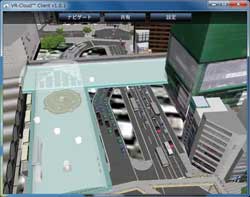 |
|
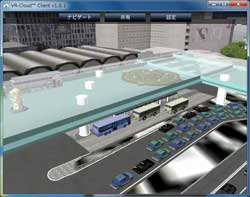 |
| "Examination how to show" |
|
1: Start by showing the overview |
|
2:"Universal design" that allows access from bus terminal via
elevator |
 |
|
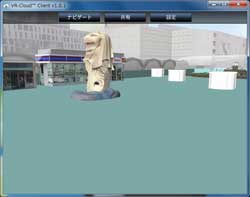 |
3:The view point moved to the
interior part of the deck.
|
|
4:By flying through every part of the deck from pedestrian's view point,
and they showed the concept that the deck is not only the place where people
pass through, but also where people gather.
|
B team (Team "Shibuya 8")
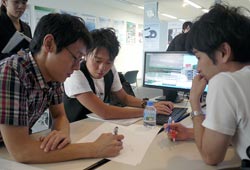 |
|
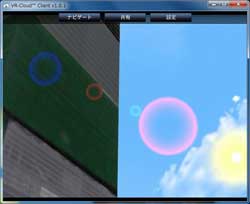 |
|
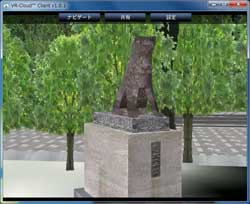 |
| "Examination how to show" |
|
1:Started to show the image of Hikarie = near future. |
|
2:Showed "Hachiko", the original idea of the symbol. |
 |
|
 |
| 3:Checked the shape of direct connection to Hikarie from panoramic view |
|
4:Created the bright and open space with daylight to make it look attractive |
|
Mr. Kasagi reviewed the presentation of each team.
"The participants may now know that UC-win/Road is a tool with great
flexibility. In a way, this flexibility can be a challenge for you. If
you want to use various functions, you will not focus on what you really
want to show. Therefore, the concept, in other words, the simplicity will
be the most important point. ." (Mr. Kasagi)
In addition, he said "A group has many ideas, but if you use all of
them, the works will become too long". And then, he advised "It
will be clearer if you emphasize the feature of each work based on the
focused point." Finally, Mr. Kasagi mentioned on how to show in the
project of city development as an advice for the students, and closed the
final workshop. "The image of city is made up by assuming how each
project works in the entire project. When the assumption becomes clearer,
the image of the city will have increased realism. Then, the deep discussion
and study of the concept is the most important thing, which will win greater
persuasive force."
For the detailed information of Virtual Design World Cup, please see here.
|
|
  Shibuya sample models for Virtual Design World Cup Shibuya sample models for Virtual Design World Cup
All participants of this student BIM contest can use the rental service
of the objective software for the specific period without charge, and download
service of these sample models.
[Rental period]: Until November 30, 2011(The rental period and available
functions may change based on the product.)
| Virtual Reality/VR Simulation |
UC-win/Road Required software
This sample model represents the geographical data, road, and buildings
in 3D VR. The space can be freely simulated with mouse operation. It can
allow the study of planning and design by simulating a variety of scenes
including traffic vehicle, human, traffic control, and sunshine condition.
With data links from Allplan, the entire landscape, surrounding environment,
and road can be studied. The analysis result can be visualized by linking
with each type of analysis software such as traffic stream, crowd analysis,
and flood analysis.
|
| 3D Civil Engineering and Architecture CAD for BIM |
Allplan Required software
In this sample model, the designs of structures created by UC-1 series
"Bridge Pier Design" and "Abutment Design" in Allplan
format or IFC format were imported to Allplan, and the skeleton and
reinforcement were represented and edited directly in 3D environment. With
these edited bar arrangement, 2D bar arrangement (Plan view and section
view), rebar bending schedule, and BOM(bills of materials) can be generated.
The created architecture and civil structures in 3DS format can be imported
to UC-win/Road. This sample model represents the pedestrian deck from Hachiko exit to
Shibuto cine tower.
|
|
|
VR-Studio(R)
VR-Studio(R) supports for the large-scaled project including a wide range
of geographical data, and it allows the creation of VR data and traffic
network of a large-scaled city having an area of 100km or more.
|
| 3D plate dynamic non-linear analysis |
Engineer's Studio(R)
Engineer's Studio(R) is the 3D Finite Element FEM analysis program developed
in-house from pre-processing, calculation engine, to post-processing. The
parts of structure can be modeled with plate elements and the non-linear
behavior of structure can be analyzed. This sample model was created by
modeling the floor plate of deck with plate elements.
|
| 3D frame static and dynamic non-linear analysis |
UC-win/FRAME(3D)
FRAME(3D) allows the geometrical non-linear/material non-linear analysis
with static and dynamic load. The advanced interface supports for general-purpose
linear analysis and elastic analysis. This sample model is available for
the study of the number of columns and the prediction of dynamic response
when the earthquake occurs.
|
| Civil design CAD |
UC-1 for SaaS
UC-1 for SaaS is a cloud service for civil design software such as UC-1
Series, RC section, FRAME 2D, Engineer's Studio(R) and clerical work software
for civil design. These products support the total works from design calculation
of bridge pier with reinforced concrete, inverted T-section abutment, and
gravity-type abutment to creation of drawings. This sample model allows
the verification of static bearing force using "UC-1 Bridge Pier Design".
|
| 3D static/dynamic analysis of architectural structures |
Multiframe
This software allows the creation and effective analysis of a various types
of complex structure including large scale structure and tall building.
This sample model allows the analysis with complex shape by giving the
wind to the roof of corridor as area distributed load.
|
| Building energy simulation |
DesignBuilder
The simulation of environmental related issue of the building under construction
such as light, temperature, and CO2 discharge is possible. It is useful
for energy saving design.This sample model allows the study of temperature
rise in a bus which is stopping under the pedestrian deck.
|
| Planning of traffic light and intersection/Traffic stream analysis |
OSCADY / TRANSYT
The software for optimization of traffic signal and traffic signal control
in traffic network. The flow of signal phase and queue length of congestion
can be simulated. This sample model allows the analysis of the intersection
in front of Shibuya station.
|
| Flood analysis system (Design of sewage network, flood analysis) |
xpswmm
It is useful in creating a water storage reservoir underground above pedestrian
deck and analyzing the flood of Shibuya river. This sample model allows
the study of water's flow to the storage reservoir which is planned
to be constructed under the bus terminal.
|
|
|
|








